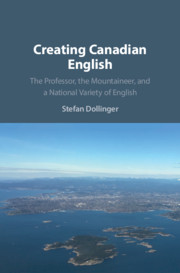Book contents
- Creating Canadian English
- Frontispiece
- Creating Canadian English
- Copyright page
- Dedication
- Contents
- Figures
- Tables
- Preface
- Acknowledgements
- A Note to the International Reader
- 1 What is Canadian English?
- 2 The Heritage of Canadian English
- 3 Avis Pulls It Off
- 4 The “Technology”: Slips, Slips, and More Slips
- 5 1967 – Excitement and Hype
- 6 Riding the Wave of Success
- 7 A Global Village and a National Dictionary War
- 8 Decolonizing DCHP-1 and DCHP-2
- 9 Is There Really a Canadian English?
- Notes
- Further Reading
- Bibliography
- General Index
4 - The “Technology”: Slips, Slips, and More Slips
Published online by Cambridge University Press: 24 June 2019
- Creating Canadian English
- Frontispiece
- Creating Canadian English
- Copyright page
- Dedication
- Contents
- Figures
- Tables
- Preface
- Acknowledgements
- A Note to the International Reader
- 1 What is Canadian English?
- 2 The Heritage of Canadian English
- 3 Avis Pulls It Off
- 4 The “Technology”: Slips, Slips, and More Slips
- 5 1967 – Excitement and Hype
- 6 Riding the Wave of Success
- 7 A Global Village and a National Dictionary War
- 8 Decolonizing DCHP-1 and DCHP-2
- 9 Is There Really a Canadian English?
- Notes
- Further Reading
- Bibliography
- General Index
Summary
This chapter addresses the nitty-gritty of dictionary making in the pre-digital era. Focussing on the quotation slip in lexicography, which is an attested use of a target word in context, the chapter explains the problems of editing a dictionary in an era when unique, physical paper files had to be sent back and forth across a vast country. With Avis working in Ontario and the dictionary centre located in British Columbia, and Lovell working early on from Illinois, the Dictionary of Canadian English depended on reliable postal delivery by Canada Post. Quotation slips on First Nations band names from the archives show the amount of documentation that the Dictionary of Canadianisms, the "Canadian OED", required, not without highlighting the challenges of Avis taking over Lovell's data collection and of co-editors working together despite being located in very different places. Based on extant correspondence between Avis, Douglas Leechman, Charles Crate, and Joan Hall, the editorial assistant, the genesis of the defining dictionary of Canadian English is traced in considerable detail. Etymologies of Canuck and beaver stone, the latter going back to Early Modern times, round off this more technical chapter.
Keywords
- Type
- Chapter
- Information
- Creating Canadian EnglishThe Professor, the Mountaineer, and a National Variety of English, pp. 86 - 117Publisher: Cambridge University PressPrint publication year: 2019

